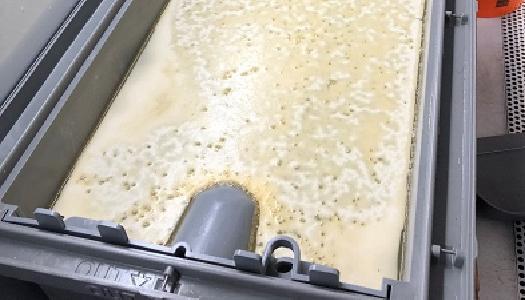Fats, Oils and Grease (FOG)

Our team is working on a project for the CRD involving the passage of fats, oils, and grease (FOG) through the sanitary system. The CRD estimates about 1,000,000 kg of FOG is introduced into the sanitary system per year from residential areas, and that only makes up 60% of all FOG released (Capital Regional District, n.d.). A buildup of FOG can incur huge costs in repairs from blockages (look up “fatberg” if you have a strong stomach). We have taken two grease traps similar to the ones installed in all CRD restaurants and hooked them up in series to see how efficient they are at separating a set volume of FOG from wastewater.
We are testing the efficiency when the running water is at 15, 35 and 55°C under four conditions: no detergent, with detergent, with sanitizer, and with detergent and sanitizer. We expect that colder water temperatures increase efficiency, detergents decrease efficiency, and sanitizers decrease efficiency.
So far, our predictions seem to be accurate where higher temperatures are less efficient, and detergents dissolve FOG and therefore decrease the efficiency. When we ran the statistical analysis, we found out that we have a p-value slightly more than alpha, suggesting that there may be a relationship, but we need to run more tests to confirm.
Over the next four weeks, we aim to finish our trials and begin writing up our final report. Once we have all of the data, we can confidently say what impact each condition has on the efficiency of grease interceptors and what the optimum running conditions are.
References:
Capital Regional District. (n.d.). Fats, Oils, and Grease: We've put our sink on a fat-free diet. Retrieved from Capital Regional District: https://www.crd.bc.ca/education/stormwater-wastewater-septic/at-home/protecting-plumbing-treatment/fats-oils-and-grease